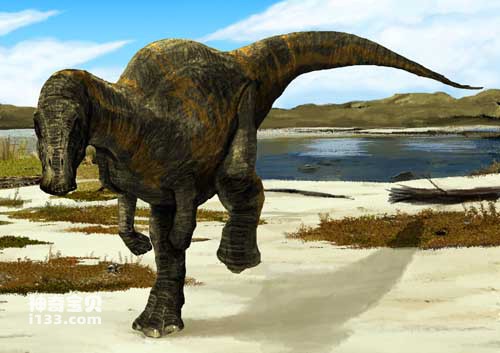Since Reddy named the duck-billed dinosaur in 1858, this latest dinosaur quickly became a big star, not only because of its huge body and strange mouth, but also because before the end of the dinosaur age in North America, the duck-billed Dragons are found throughout the continent, so their remains are unearthed in large numbers, and fossils are often found in very well-preserved conditions. Even their skin fossils are unearthed from time to time. The most famous of them is the duck-billed dinosaur mummy discovered by Sternberg in Kansas in 1908. When Sternberg found it, the poor animal still maintained the same appearance as when it died more than 70 million years ago. The body was lying on its back with its two hind legs raised. It is not difficult to see that the duck-billed dinosaur had a painful convulsion before it died. Fortunately, the corpse was not damaged by scavengers, and it quickly completed the dehydration stage under the scorching sun, and was miraculously preserved by being covered with fine sand and gravel. If there was any mistake in this, this treasure would not be presented to us.
The hadrosaurus is about 10 meters long and feeds on plants. It has a tall skull and a pair of large eyes on both sides of its cheeks. It is similar to the eyes of horses and cows because it can move upward and has relatively large eyes. Optic nerve, so hadrosaurs had very good eyesight and were able to maintain a high degree of vigilance against carnivorous dinosaurs. The beak of the hadrosaur is called "hadrosaur" because of the extension and lateral expansion of the premaxillary and predentary bones, forming a broad duck-like snout.
Speaking of the characteristics of the hadrosaurus, its name already tells us that it has a flat, duck-billed mouth. The flat mouth is densely packed with 2,000 diamond-shaped teeth (probably the species with the most teeth among the dinosaurs that have been discovered). In addition to their astonishing number, these teeth have another characteristic. They are slanted and overlap each other. They have washboard-like abrasive surfaces on the teeth. The old teeth are worn away and new ones grow out to replenish them. Moreover, the teeth of the hadrosaur's upper and lower jaws can interlock and bite. Coupled with the developed joint system and strong muscles, they can freely promote the movement of the upper and lower jaws, so these teeth can cut off tough plant fibers and grind them into paste. It can be seen that they are very efficient eating machines.
Compared with earlier herbivorous dinosaurs, this tooth arrangement improved the efficiency of grinding food. Plants used changes in their own structure to adapt to the transition from the warm and humid Jurassic to the drier Cretaceous, while herbivorous dinosaurs continued to evolve following changes in food. Advances in hadrosaurs' food-processing mechanisms enhanced their ability to adapt to their environment, making them one of the most successful herbivorous dinosaurs of the Cretaceous.

Chinese name: Hadrosaurus
Latin name: Hadrosaurus
Age of survival: Late Cretaceous
Fossil origin: New Jersey, USA
Physical characteristics: 7~10 meters long
Diet: plants
Species: Ornithopods
Definition: A lizard with a mouth like a duck
animal tags: Hadrosaurus
We created this article in conjunction with AI technology, then made sure it was fact-checked and edited by a Animals Top editor.